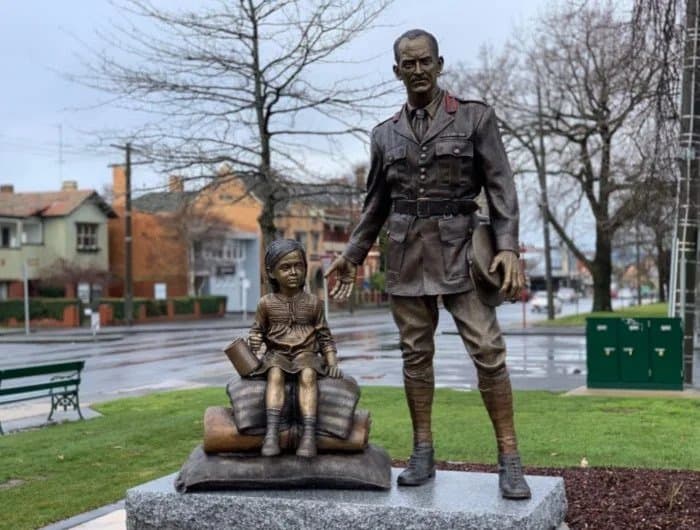Australian military officer George Treloar saved thousands of Pontian Greek refugees who fled their ancestral homes in Turkey in the 1920s.

In 2019 Greek Australians raised money to create a statue of Treloar, the saviour of Pontus Hellenism.
Seated next to Treloar in the sculpture is a young girl nicknamed Lemona, holding a jug. She represents the hundreds of thousands of refugees from the Pontus region.
Having to choose between death and exile, hundreds of thousands of Greek Pontians, who lived for thousands of years in the region of today’s northern Turkish coast and spoke a dialect very close to the original ancient Greek language, were forced to move to Greece to save their lives.
Ballarat-born Treloar is credited with assisting over 108,000 Christian refugees who were forced to flee their ancestral homes across Asia Minor in the wake of the catastrophe in the early 1920s. As the official League of Nations Refugee Commissioner in northern Greece, George ensured the survival of these desperate and almost destitute civilians, providing accommodation, food, health care and work. Some 13 new villages were established, one of which was named by Greece in his honour, the Thracian village of Thrylorion. It has been said that without his organisation and dedication, many of these refugees may not have survived.
Between 1922 and 1926. He was engaged in the resettlement of Greek refugees from Asia Minor; at first he worked at Gumuldjina (Komotini) in Thrace and later in Salonika.
In the 1940s and after World War II, many of these Pontian Greek refugees emigrated to Australia.
In an attempt to honour the Australian man who saved the lives of their ancestors, their children and grandchildren created a statue of him in Ballarat, Melbourne Australia.
Distinguished military career
The statue of Treloar unveiled in Ballarat, where he was born on 23 April 1884 and educated at Ballarat’s St Patrick’s College.
Having served at Ballarat as a lieutenant in the 3rd Victorian Rifles, Treloar immediately volunteered.
Although rejected because of defective eyesight, he somehow managed to join the 20th Middlesex (Artists) Rifle Volunteers in 1915 as a private and secured a transfer to the Coldstream Guards.
He served in France, was commissioned and ultimately promoted to major, second-in-command of the 3rd Battalion. Buried twice by shell bursts on the Somme and almost bullet-riddled at Ypres, he was awarded the Distinguished Service Order and the Military Cross.
In 1918 he commanded the Brigade of Guards Officers’ School of Instruction and, following the Armistice, served with his Battalion in the Rhineland Occupation Force.
After World War One, Treloar joined the British Mission to the White Russian armies as assistant military secretary to Major-General Holman.
At Constantinople, after the mission’s withdrawal, Treloar served with the Tsarist army as a colonel under Baron Wrangel.
After the White Russians were defeated, Treloar commanded a British camp for Russian refugees at Tousla on the Sea of Marmora. He then became a representative of the League of Nations High Commissariat for Refugees in northern Greece.

